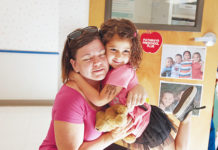
The sandwich generation finds themselves caught between caring for their own children and caring for their parents.
When Naz Deravian became a mom for the first time, she found herself embracing her new baby girl, Luna, and her new role, with utter joy. But the 36-year-old actor was also worried about her own mom, who at the time was undergoing treatment for breast cancer.
Deravian’s 73-year-old mother’s cancer is now in remission, but she still suffers from debilitating arthritis. Now Deravian has started to think about how best to look after her mom while raising her daughter and keeping her own professional career on track.
A New Reality
This difficult situation exists in thousands of families across the nation. Deravian represents a new reality dubbed the sandwich generation–the need to take care of both an older and a younger generation simultaneously.
“It’s a subject we’ve had to take a good look at lately,” Deravian says on the phone from her home in Los Angeles, where she moved from Vancouver a decade ago. “It’s always in the back of my mind.”
Deravian explains that the geo-graphical distance from her mom, who still lives in British Columbia, adds to the challenge. While many people opt to have their elderly parents live with them or at least nearby, picking up and moving to another city makes things even more complex. “It’s a big question,” she states.
Feeling the Squeeze
The cycle of parents first taking care of their children, before those same children end up taking care of their own parents, is not an unusual one. But modern life has skewed this natural pattern. Now marriage and motherhood tend to happen later in life.
Consequently more people are caring for their aging or ailing parents by going to doctor’s appointments with them, doing daily chores, and mitigating the effects of physical or mental decline.
At the same time, people are rearing kids–zipping them to sports practices, helping with homework, and making meals. Sometimes elder care and childcare take place all under one roof. Add in the demands of the workplace and it is no wonder members of the sandwich generation are feeling squeezed.
Now more than 2.5 million Canadians between the ages of 45 and 64 are the caregivers for two generations. Their ranks will further grow as baby boomers age. More than eight in 10 sandwich generation members also have jobs, and about 70 percent of those workers say they’re stressed out.
Multigenerational caregiving is nothing new, but the phenomenon is increasingly prevalent for several reasons that go beyond later-life pregnancies. Current low birth rates mean fewer family caregivers. With more women in the workforce, fewer are at home to provide full-time care. There’s also the issue of increased life expectancy, which in 2004 surpassed 80 years for both sexes.
Children are now staying at home longer. In 2006, 44 percent of Canadians aged 20 to 29 were living with their parents, up from 28 percent in 1981. Furthermore, community resources are often lacking. In the US more than 80 percent of long-term care is provided by unpaid caregivers, usually family or friends.
Paying the Price
Women are particularly affected by the pressures of the sandwich generation. Traditional gender roles come into play, with women being more likely than men to shoulder the burden of child and elder care, even if both spouses are working. Women are more likely to compromise their careers in order to fulfill their familial obligations, and they’re more likely to experience the emotional distress that accompanies caregiving.
Being in the sandwich generation takes more than an emotional toll. According to Linda Duxbury of Carleton University’s Sprott School of Business, one of the main consequences of multiple caregiving responsibilities is a type of stress called caregiver strain. This stress can leave people physically, mentally, and financially drained.
Those who have elderly dependents living with them will often experience the highest levels of strain, given that these parents tend to be in poorer health, which makes it harder to escape caregiving demands. In fact employees with high caregiver strain were twice as likely as those without strain to have sought care from a mental health professional.
At work this results in absenteeism, costing the Canadian economy over $1 billion per year, according to Duxbury. Plus to keep up with caregiving demands, 15 percent of sandwiched workers have reduced their work hours, while 10 percent have experienced a reduction in income.
Preparing for Caregiving
Deravian notes that she, her husband, and her extended family have had frank discussions about how they will accommodate her mom in the future–discussions that her mom has also participated in.
“We need to have these conversations now, not five years from now, not in the middle of a crisis,” she says. “People don’t think straight when they’re in crisis mode.”
If she doesn’t have all the answers, at least Deravian isn’t ignoring her circumstances. According to Ontario psychologist Peter Marshall, although many people recognize that their parents will one day need help, many remain woefully unprepared.
“Given the inevitability of the situation, it seems odd that we pay so little attention to how we might prepare ourselves for changes in our family lives.” In Two Jobs, No Life: Learning How to Balance Work and Home (Key Porter Books, 2001), Marshall writes, “We often seem to wait until problems arise … those entering the sandwich generation will find themselves in unfamiliar territory.”
Part of what makes multigenerational caregiving so tough, Marshall explains, is that it stirs complex emotions. “Raising children almost always takes place in an atmosphere of optimism and hope,” he writes. “We watch them grow and applaud their achievements. The hard times and rough periods rarely go on forever. Watching our parents deteriorate, we cannot help but be aware of how much they have lost … the future often seems both uncertain and bleak.”
Coping With Caregiving
Fortunately there are many ways members of the sandwich generation can cope. Find out exactly what kind of assistance elderly parents need. They’ll likely require help with everyday tasks such as shopping, banking, going to doctor’s appointments, taking medication, cleaning, cooking, and doing home repairs. They might need a hand with personal, financial, and legal affairs, including establishing power of attorney. It’s important to find out parents’ wishes regarding funerals and life support, Marshall says, and to know the location of their wills.
Also divide the work among family members. “I recommend being quite specific,” Marshall advises. “Just securing a commitment that a family member will help may not actually lead to any action. It can be much more productive to have a family meeting in which each person is given a list of what needs to be done.”
Ontario’s Family Services Employee Assistance Programs Thames Valley (FSTV), which provides support and counselling, points out that caregivers also need to take care of themselves. FSTV suggests that people let go of any guilt they might feel about taking necessary time to relax, exercise, see friends, and nurture important relationships. The organization also recommends that caregivers monitor themselves for signs of burnout or depression, and speak with a doctor or a counsellor if necessary.
Susan Pilgrim, author of Living InSync–Creating Your Life with Balance and Purpose (Health Communications, 1995), says one way of dealing with so many conflicting demands is to simplify your life. “Look at what is extraneous,” she says. “Eliminate what you really don’t want to do or don’t have the time to do anymore.”
Pilgrim also urges people to encourage as much independence in their parents as possible. “Refrain from doing for others what they can do for themselves,” she writes.
Some caregivers may seek solace in friends or church groups. Others may find help from organizations such as the Alzheimer Society of Canada (alzheimer.ca) or the Family Caregivers Network Society (fcns-caregiving.org), which offer support groups. Many employee assistance programs also offer free or inexpensive counselling.
Finding the Rewards
Clearly, minding two generations can be overwhelming. But it also has its rewards: about 95 percent of those in the sandwich generation report feeling satisfied with life in general, according to Statistics Canada. More than 60 percent of caregivers in the sandwich generation have said that they feel they are involved in giving back some of what their elderly charges had previously given to them.
Additionally, 70 percent feel that their relationship with mom or dad has been strengthened through administering care. While caregiving is clearly difficult to integrate with life’s many other obligations, just 5 percent of people found it to be an extreme burden.
Ultimately, having young kids at home can help. Aside from doing chores, children are a source of abundant joy. They can be involved in elder care as well, even if it’s just stopping for a short visit before or after school.
For Deravian, there’s the delight in seeing her older mom play with her younger daughter. “Luna is a major inspiration to her,” says Deravian. “She’s determined to be a great grandma.”





























